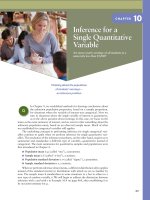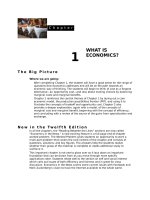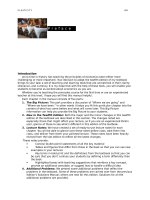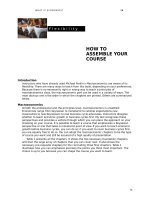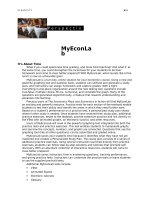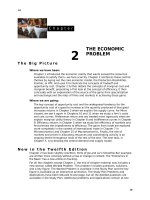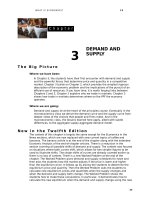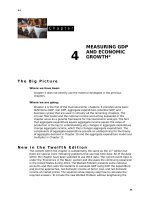The big picture marcoeconomics 12e parkin chapter 10
Bạn đang xem bản rút gọn của tài liệu. Xem và tải ngay bản đầy đủ của tài liệu tại đây (578.12 KB, 15 trang )
W H AT I S E C O N O M I C S ?
85
1
0
AGGREGATE
SUPPLY AND
AGGREGATE
DEMAND**
The Big Picture
Where we have been:
This chapter provides the work horse model, the aggregate supply-aggregate
demand model, used to explore answers to the questions about short-run
macroeconomic issues. The chapter uses the fact established in Chapter 4,
that expenditure equals C + I + G + (X – M), to explain the forces that
determine aggregate demand. It also draws on Chapter 3, demand and
supply, for the crucial concepts of equilibrium and the distinction between
shifts and movements along demand and supply curves.
Where we are going:
This chapter provides a description of the AS-AD model. The treatment
parallels that of the demand and supply model in Chapter 3. That is, the
curves are defined and the reasons for their slopes and the factors that shift
them are explained. But the curves are not formally derived. The next chapter
more formally derives the aggregate demand curve from the aggregate
expenditure curve. It lays out the aggregate expenditure model, explains the
multiplier effect of changes in investment, describes the adjustment process
that moves the economy toward the AD curve, and derives the AD curve from
the AE equilibrium. Then Chapters 12, 13, and 14 make use of the aggregate
supply-aggregate supply framework to explore business cycles and inflation,
fiscal policy, and monetary policy.
N e w i n t h e Tw e l f t h E d i t i o n
All the data are updated through 2014 and a discussion of the World Economy
Headwinds in Economics in Action has been added. The Economics In The News
feature has a 2014 article about stronger than expected rebound in the U.S.
economy, which applies the AD-AS model. The Worked Problem presents
aggregate demand and short-run aggregate supply schedules and then asks the
85
86
short-run equilibrium real GDP and price level. It also asks the effect of an
increase in aggregate demand. The solutions to the problems use both the
aggregate demand and short-run aggregate supply schedules and an AD-SAS
figure. To include the new Worked Problem without lengthening the chapter, some
problems have been removed from the Study Plan Problem and Applications.
These problems are in the MyEconLab and are called Extra Problems.
86
Lecture Notes
Aggregate Supply and Aggregate Demand
The aggregate supply-aggregate demand (AS-AD) model explains how real GDP and
the price level are determined.
The model also helps explains the factors that determine inflation and the business
cycle.
Tell students that there is heated debate among economists on the most important
influences in the macro economy and how to model those influences. Economists as a
group are ambivalent about the aggregate supply-aggregate demand (AS-AD) model. Real
business cycle theorists, who like to build their models from the base of production
functions and preferences, don’t use the model because the AS and AD curves are not
independent. Technological change shifts both the AS and AD curves simultaneously and in
complicated ways. New Keynesian economists have dropped the model in favor of a
dynamic variant that places the inflation rate on the y-axis and the output gap (real GDP
minus potential GDP as a percentage of potential GDP) on the x-axis. Despite the
controversy, the AS-AD model is the key macroeconomic model for most economists. The
model plays a similar role in the organization of the macroeconomics to that played by the
demand and supply model in microeconomics. The author does a good job of using the ASAD model to explain various schools of thought.
The AS-AD model is the best model currently available for introducing students to
macroeconomics. It enables them to gain insights into the way the economy works, to
organize their study of the subject, and to understand the debates surrounding the effects
of policies designed to improve macroeconomic performance.
Devoting at least a week of lecture time to the AS-AD model is worthwhile. Your goal at this
point in the course is to help them understand the components of the model intuitively and
to put the model to work using some of its more simple and obvious features.
I. Aggregate Supply
The quantity of real GDP supplied is the total quantity of goods and services, valued in
constant dollar prices, that firms plan to produce in a given time period. This amount
depends on the quantity of labor employed, the capital stock, and the state of
technology. In the short run, only the quantity of labor can vary, so fluctuations in
employment lead to changes in real GDP.
Long-Run Aggregate Supply
The long-run aggregate supply curve
the relationship between the quantity of
real GDP supplied and the price level in
the long run when real GDP equals
potential GDP. As illustrated in the figure,
the LAS curve is vertical at the level of
potential GDP ($13 trillion in the figure),
showing that potential GDP does not
depend on the specific price level.
In the long run, the wage rate and other
resource prices change in proportion to
the price level. So moving along the LAS
curve both the price level and the money
wage rate change by the same
percentage.
is
A G G R E G A T E S U P P LY A N D A G G R E G AT E D E M A N D
Short-Run Aggregate Supply
The short-run aggregate supply curve is the relationship between the quantity
of real GDP supplied and the price level in the short run when the money wage rate,
the prices of other resources, and potential GDP remain constant.
As illustrated in the figure, the SAS curve is upward sloping. This slope reflects that a
higher price level combined with a fixed money wage rate, lowers the real wage rate,
thereby increasing the quantity of labor firms employ and hence increasing the real
GDP firms produce.
Difference between LAS and SAS: The distinction between the LAS and the SAS comes
about by assuming that resource and output prices adjust at different rates. Ask the class,
“When there is an increase in demand, what do you think adjusts first, prices of goods on
the shelves at Wal-Mart or wages of employees at Wal-Mart?” By discussing out the
potential lag times in resource price adjustment, you have opened up a hotly contested
item among economists. How long is that lag time? Tell the students that there are different
schools of thought about this issue and during the term we will see how different
assumptions yield different answers.
Movements Along the LAS and SAS Curves and Changes in Aggregate Supply
Movements Along the Curves
When the price level, the money wage rate, and other resource prices change by the
same percentage, real GDP remains at potential GDP and there is a movement along
the LAS curve.
When the price level changes and the money wage rate and other resource prices
remain constant, real GDP departs from potential GDP and there is a movement
along the SAS curve.
Shifts in the Curves
When potential GDP increases, both long-run and short-run aggregate supply
increase and the LAS and SAS curves shift rightward. Potential GDP increases when
the full employment quantity of labor increases, the quantity of capital increases, or
technology advances.
Short-run aggregate supply changes and the SAS curve shifts when there is a
change in the money wage rate or other resource prices. A rise in the money wage
rate or other resource prices decreases short-run aggregate supply and shifts the SAS
curve leftward.
The flavor of the Classical-Keynesian controversy. If you want to convey the flavor of
one of the biggest controversies in macroeconomics, you can do so at this early stage of
the course by using only the aggregate supply curves. The difference between the upwardsloping SAS and the vertical LAS lies at the core of the disagreement between Classical
economists who believe that wages and prices are highly flexible and adjust rapidly and
Keynesian economists who believe that the money wage rate in particular adjusts very
slowly.
Along the SAS curve: You cannot repeat yourself too many times about this topic:
Moving along the SAS curve, resource prices are fixed. Point out that this is the same
assumption for the “micro” supply curve. In particular, if there is an increase in the money
wage rate at the Pepsi plant, the supply curve for Pepsi shifts leftward. That same principle
gets applied to all goods and services in the AS-AD model so an increase in the money
wage rate shifts the SAS curve leftward.
99
100
CHAPTER 10
Along the LAS curve: Students seem comfortable with the idea that the SAS curve has a
positive slope but they seem less at ease with the vertical LAS curve. Emphasize (as the
textbook does) the crucial idea that along the LAS curve two sets of prices are changing —
the prices of output and the prices of resources, especially the money wage rate. Once they
get this point, students quickly catch on to the result that firms won’t be motivated to
change their production levels along the LAS curve. The vertical LAS curve is both vital and
difficult and class time spent on this concept is well justified. Though you do not “need” to
emphasize this point, what the LAS curve illustrates is that the real economy is
independent of money prices!
II. Aggregate Demand
The quantity of real GDP demanded is the sum of consumption expenditure (C),
investment (I) , government expenditure (G), and net exports (X M), or Y = C + I +
G + (X M).
Buying plans depend on many factors including:
The price level
Expectations
Fiscal policy and monetary policy
The world economy
The Aggregate Demand Curve
Other things remaining the same, the higher
the price level, the smaller is the quantity of
real GDP demanded. The relationship
between the quantity of real GDP demanded
and the price level is called aggregate
demand. As the figure shows, the AD curve
is downward sloping.
The negative relationship between the
price level and the quantity of real GDP
demanded reflects the wealth effect
(when the price level rises, real wealth
decreases and so people decrease
consumption) and substitution effects
(first, the intertemporal substitution
effect: when the price level rises, real money decreases and the interest rates
rises so that consumption expenditure and investment decrease; and, second,
the international price substitution effect: when the price level rises, domestic
goods become more expensive relative to foreign goods so people decrease the
quantity of domestic goods demanded).
Keep it simple. You know that the AD curve is a subtle object—an equilibrium relationship
derived from simultaneous equilibrium in the goods market and the money market. This
description of the AD curve is not helpful to students in the principles course and is a topic
for the intermediate macro course. At the same time that we want to simplify the
aggregate demand story, we also want to avoid being misleading. The textbook walks that
fine line, and we suggest that you stick closely to the textbook treatment and don’t try to
convey the more subtle aspects of aggregate demand.
A major problem with the AD curve is that a change in the price level that brings a
movement along the curve is not a strict ceteris paribus event. A change in the price level
A G G R E G A T E S U P P LY A N D A G G R E G AT E D E M A N D
changes the quantity of real money, which changes the interest rate. Indeed, this chain of
events is one of the reasons for the negative slope of the AD curve. In telling this story, we
must be sensitive to the fact that the students don’t totally appreciate the ceteris paribus
condition. We must provide intuition with stories such as the Maria stories in the textbook.
Income equals expenditure on the AD curve. Some instructors want to emphasize a
second and more subtle violation of ceteris paribus, that along the AD curve, aggregate
planned expenditure equals real GDP. That is, the AD curve is not drawn for a given level of
income but for the varying level of income that equals the level of planned expenditure. If
you want to make this point when you first introduce the AD curve, you must cover the AE
model in the next chapter before you cover this chapter. (The material is written in a way
that permits this change of order.) If you do not want to derive the AD curve from the
equilibrium of the AE model, don’t even mention what’s going on with income along the AD
curve. Silence is vastly better than confusion. You can pull this rabbit out of the hat when
you get to the next chapter if you’re covering the material in the order presented in the
textbook.
Changes in Aggregate Demand
Any factor that influences buying plans other than the price level brings a change in
aggregate demand and a shift in the aggregate demand curve. Factors that change
aggregate demand are:
Expectations: Expectations of higher future income, expectations of higher future
inflation, and expectations of higher future profits increase aggregate demand
and shift the AD curve rightward.
Fiscal policy and monetary policy: The government’s attempt to influence the
economy by setting and changing taxes, making transfer payments, and
purchasing goods and services is called fiscal policy. Tax cuts or increased
transfer payments increase disposable income (aggregate income minus tax
payments plus transfers) and thereby increase consumption expenditure and
aggregate demand. Increased government expenditures increase aggregate
demand. Monetary policy consists of changes in interest rates and in the
quantity of money in the economy. An increase in the quantity of money and
lower interest rates increase aggregate demand.
The world economy: Exchange rates and foreign income affect net exports (X
M) and, therefore, aggregate demand. A decrease in the exchange rate or an
increase in foreign income increases aggregate demand.
III. Explaining Macroeconomic Trends and Fluctuations
Short-Run and Long-Run Macroeconomic Equilibrium
Short-run macroeconomic equilibrium occurs when the quantity of real GDP
demanded equals the quantity of real GDP supplied. This equilibrium is determined
where the AD and SAS curves intersect.
If the quantity of real GDP supplied exceeds the quantity demanded, inventories
pile up so that firms will cut production and prices.
If the quantity of real demanded exceeds the quantity supplied, inventories are
depleted so that firms will increase production and prices.
Short-run macroeconomic equilibrium. Emphasize that in short-run macroeconomic
equilibrium, firms are producing the quantities that maximize profit and everyone is
spending the amount that they want to spend. Describe the convergence process using the
mechanism laid out in the textbook. In that process, firms always produce the profitmaximizing quantities—the economy is on the SAS curve. If they can’t sell everything they
produce, firms lower prices and cut production. Similarly, they can’t keep up with sales and
101
102
CHAPTER 10
inventories are falling, firms raise prices and increase production. These adjustment
processes continues until firms are selling their profit-maximizing output.
Long-run macroeconomic equilibrium
occurs when real GDP equals potential GDP—
equivalently, as the figure shows, when the
economy is on its long-run aggregate supply
curve. The figure shows the long-run
macroeconomic equilibrium at a real GDP of
$16 trillion and a price level of 110.
From the short run to the long run. Explain that market forces move the money wage
rate to the long-run equilibrium level. At money wage rates below the long-run equilibrium
level, there is a shortage of labor, so the money wage rate rises and employment
decreases. At money wage rates above the long-run equilibrium level, there is a surplus of
labor, so the money wage rate falls and employment increases. At the long-run equilibrium
money wage rate, there is neither a shortage nor a surplus of labor and the money wage
rate remains constant and employment is constant at its full employment level.
Economic Growth and Inflation
Economic growth occurs when potential GDP increases so that the LAS curve shifts
rightward.
Inflation occurs when the AD curve continually shifts rightward at a faster rate than
the LAS curve. In the long run, only growth in the quantity of money makes the AD
curve continually shift rightward.
The Business Cycle
The business cycle occurs because aggregate demand and aggregate supply fluctuate and
the money wage rate does not adjust quickly enough to keep the economy at potential GDP.
A below full-employment equilibrium is a macroeconomic equilibrium in which
potential GDP exceeds real GDP. The gap between real GDP and potential GDP is the
output gap. With a below-full employment equilibrium, the gap is called a
recessionary gap. A recessionary gap occurs when the SAS curve and the AD
curve intersect to the left of the LAS curve.
An above full-employment equilibrium is a macroeconomic equilibrium in which
real GDP exceeds potential GDP. The amount by which real GDP exceeds potential
GDP, the output gap, is called an inflationary gap. An inflationary gap occurs
when the SAS curve and the AD curve intersect to the right of the LAS curve.
A full-employment equilibrium is a macroeconomic equilibrium in which real GDP
equals potential GDP.
The figure below to the left shows a below-full employment equilibrium with a
recessionary gap of $1 trillion. The figure on the right shows an above fullemployment equilibrium with an inflationary gap of $1 trillion.
A G G R E G A T E S U P P LY A N D A G G R E G AT E D E M A N D
Point out to the students that to simplify analysis of the business cycle, economists
typically abstract from the long-term persisting increases in the LAS curve and AD curve
that generate economic growth and inflation, respectively. So, by fixing the LAS curve when
considering business cycle fluctuations, economists are looking at short-term movements
around a slower moving long-run equilibrium level of output. Explain to the students that
one reason to abstract from these long-term movements is simply that the figures get very
complicated if all the curves shift rather than just the immediately relevant ones. A second
reason is the standard view that short-term movements around the LAS are driven by
different economic forces than the persisting long-run shifts in the LAS curve. So
abstracting from long-term growth in order to focus on business cycle fluctuations
simplifies matters without any loss of relevant details.
An Economics in Action feature discusses the
“World Economy Headwinds”—slowing real GDP
growth—that threaten to decrease U.S. exports and
thereby leave a recessionary gap in the United
States.
Fluctuations in Aggregate Demand
An increase in aggregate demand shifts the AD
curve rightward, as in the figure where the
aggregate demand curve shifts from AD0 to AD1. In
103
104
CHAPTER 10
the short run, a rightward shift of the AD curve leads to movement along the SAS curve so
that both the price level and real GDP increase. In the figure the economy moves from an
initial equilibrium at point a with real GDP equal to potential GDP of $16 trillion and a price
level of 100 to point b with real GDP of $17 trillion and a price level of 105. But in the long
run, the higher price level and tight labor market lead to an increase in the money wage
rate. Short-run aggregate supply decreases and the SAS curve shifts leftward, in the figure
from SAS0 to SAS 1. The long-run equilibrium is reached when the short-run aggregate
supply has decreased enough so that the economy is back producing at potential GDP,
which in the figure occurs when the economy moves from b to point c. In the long run, the
increase in aggregate demand has no effect on real GDP—it has returned to potential GDP,
$16 trillion in the figure--and only results in a higher price level—which has risen from 100
to 110 in the figure.
Shifting the SAS curve. Reinforce the movement toward long-run equilibrium with a
curve-shifting exercise. Take the case where the AD curve shifts rightward. The fact that the
initial equilibrium occurs where the new AD curve intersects the SAS curve is not difficult.
But the notion that the SAS curve shifts leftward as time passes is difficult for many
students. The trick to making this idea clear is to spend enough time when initially
discussing the SAS so that the students realize that wages and other input prices remain
constant along an SAS curve. Once the students see this point, they can understand that,
as input prices increase in response to the higher level of (output) prices, the SAS curve
shifts leftward.
Avoid confusing students by using “up” to correspond to a decrease in SAS. But do point
out that that when the SAS curve shifts leftward it is moving vertically upward, as input
prices rise to become consistent with potential GDP and the new long-run equilibrium price
level. Most students find it easier to see why the SAS curve shifts leftward once they see
that rising input prices shift the curve vertically upward.
In the figure above, instead of using identifying the short-run aggregate supply curve with
SAS0you might use SASW=$10 with the explanation that along this SAS curve the money
wage rate, W, is fixed at $10/hour. Then, rather than label the new short-run aggregate
supply curve SAS 1, can identify it as SASW=$11. You can now show your students the
qualitative point that the money wage rate has increased and you can show them the
quantitative point that the 10 percent increase in the price level (from 100 to 110) lead to
a 10 percent increase in the money wage rate.
Fluctuations in Aggregate Supply
Some business cycle fluctuations are driven by shifts in short-run aggregate supply. An
increase in energy prices decreases the short-run aggregate supply and shifts the SAS
curve leftward. The price level increases and real GDP decreases. The combination of
recession and higher inflation is called stagflation and occurred in the United States in the
1970s as a result of the oil price shocks.
IV. Macroeconomic Schools of Thought
There is a fair degree of consensus among mainstream economists about economic growth
and inflation, although there is still immense debate about the business cycle. The
importance of macroeconomic issues and the complexities of economic systems mean that
there are strong incentives to speak knowledgeably about macroeconomics, but it is
difficult for most people to evaluate whether the speaker is truly knowledgeable or a
charlatan. Mainstream economic theories are completely thought out and fully articulated.
Thus, one should be wary of anyone who confidently rejects that one of these mainstream
theories as “just plain wrong.”
A G G R E G A T E S U P P LY A N D A G G R E G AT E D E M A N D
The Classical View
A classical macroeconomist believes that the economy is self-regulating and that it
is always at full employment. A new classical view is that business cycle
fluctuations are the efficient responses of a well-functioning market economy that is
bombarded by shocks that arise from the uneven pace of technological change.
The uneven pace of technological advancement are the main source of business
cycle fluctuations. There is no distinct short-run aggregate supply curve because the
economy is always producing at potential GDP.
Classical economists emphasize that taxes blunt people’s incentives to work, so the
most the government should do to affect the business cycle is to keep taxes low.
The Keynesian View
A Keynesian macroeconomist believes that left alone, the economy would rarely
operate at full employment and that to achieve and maintain full employment,
active help from fiscal policy and monetary policy is required.
Aggregate demand fluctuations driven by changes in expectations (“animal spirits”)
about business conditions and profits are the main source of business cycle
fluctuations. Because money wages are sticky (slow to adjust), especially in the
downward direction, the economy can remain mired in a recession.
A modern version of the Keynesian view known as the new Keynesian view holds
that not only is the money wage rate sticky but that the prices of some goods and
services are also sticky.
Keynesians believe that fiscal policy and monetary policy should be used actively to
stimulate demand to end recessions and restore full employment.
Although Keynes agreed that the economy would return to its potential in the long run, he
stated, “In the long run, we are all dead”. Keynes believed that because of the interaction
between financial markets, the price level, and the labor market, there was no inherent
tendency of the market system to return quick enough to potential GDP following an
aggregate demand shock. The role of the government, in Keynes’ view, was not to replace
markets with central planning, but to use stabilization policies to help the macroeconomy
find equilibrium at potential GDP. Keynes’ analogy was that market capitalism in the Great
Depression was like a car with a broken alternator. Fiscal policy would give the economy a
jump-start when aggregate demand was inadequate. Keynes worried that without active
aggregate demand management, high unemployment would lead to a breakdown of
capitalism, with revolution leading to totalitarianism in the form of communism or fascism.
The Monetarist View
A monetarist macroeconomist believes that the economy is self-regulating and that
it will normally operate at full employment provided that monetary policy is not
erratic and that the pace of money growth is kept steady.
Aggregate demand fluctuations driven by monetary policy mistakes are the main
source of business cycle fluctuations.
There is a short-run aggregate supply curve because money wages are sticky.
The monetarist view of policy is that tax rates should be kept low and the quantity of
money should be kept growing on a steady path. Beyond these policies, however, the
government should not undertake active stabilization policy.
The Economics in the News detail discusses real GDP growth in the second quarter of 2014.
This growth was more rapid than expected, which is analyzed in terms using the AD-AS
model.
105
106
CHAPTER 10
Additional Problems
1.
Explain and draw a graph to illustrate how a depreciation of the dollar
changes the short-run equilibrium real GDP and price level.
2.
Suppose the government creates a fiscal stimulus by sending people checks
representing temporary tax cuts.
a. Explain and draw a graph to illustrate the effect of this fiscal stimulus
payments on real GDP and the price level in the short run.
b. At which type of short-run equilibrium would the government want to use
this policy?
c. Which macroeconomic school of thought would justify this policy?
d. If the government used this policy when the economy was at full
employment, explain what would happen in the long run.
e. Draw a graph to illustrate your answer to d.
3.
What is stagflation? Explain how the increase in the price of oil can cause
stagflation and draw a graph to illustrate this outcome.
Solutions to Additional Problems
1.
The depreciation of the dollar increases U.S.
net exports, which increases U.S. aggregate
demand. The increase in aggregate demand
increases real GDP and raises the price level.
These changes are illustrated in Figure 10.1.
In this figure the aggregate demand curve
shifts rightward from AD0 to AD1. As a result
real GDP increases, from $16.0 trillion to
$16.2 trillion, and the price level rises, from
119 to 121.
A G G R E G A T E S U P P LY A N D A G G R E G AT E D E M A N D
2. a. The fiscal stimulus check increased
households’ consumer expenditure. The
increase in consumption expenditure
boosted aggregate demand so the aggregate
demand curve shifted rightward. Figure 10.2
shows the effect of this change. The
aggregate demand curve shifts rightward
from AD0 to AD1. As a result real GDP
increases, in the figure from $16 trillion to
$16.1 trillion, and the price level rises, in the
figure from 119 to 121.
b. The government wants to use this type of
policy when the economy is in a below fullemployment equilibrium with a recessionary
gap.
c. Keynesian economists would support this
policy.
d. If this stimulus policy was used when the economy was at full employment, in the
short run the price rises and real GDP increases. But in the long run the money wage
rate rises to reflect the higher price level. The rise in the money wage rate decreases
short-run aggregate supply. Ultimately in the long run real GDP returns to potential
GDP so there is no long-run change in real GDP. The price level, however, rises as
short-run aggregate supply decreases. So the price level in the long-run is higher
than in the short run.
e. Figure 10.3 shows the long-run changes
described in the previous answer. After the
initial shift in the aggregate demand curve
from AD0 to AD1, the price level has risen. As
a result the money wage rate rises so that
the short-run aggregate supply curve shifts
leftward, in the figure from SAS0 to SAS 1. In
turn the price level rises still more, in the
figure ultimately to 122. Real GDP, however,
decreases and eventually returns to its initial
level, which is potential GDP and in the figure
is $16.0 trillion.
107
108
3.
CHAPTER 10
Stagflation is the combination of recession
and inflation. Increases in the price of oil
can decrease aggregate supply. The
decrease in aggregate supply raises the
price level—so there is inflation—and
decreases real GDP—so there is a recession.
Figure 10.4 illustrates these results. In this
figure the aggregate supply curve shifts
leftward from AS0 to AS1. As a result real
GDP decreases from $16.0 trillion to $15.8
trillion and the price level rises, from 118 to
120.
Additional Discussion Questions
11. “The demand curves for all products have negative slopes. For
instance, the demand curves for milk, automobiles, personal
computers, and shirts all have negative slopes. Therefore, because
the aggregate demand curve shows the demand for all products, it
too must have a negative slope.” Comment on this assertion. The
assertion is incorrect. Demand curves for goods and services such as milk and
so forth have negative slopes because the price measured along the vertical
axis is a relative price; that is, it is the price of the good or service relative to
the price of another good or service. As a result, the demand curve for these
goods or services captures the possibility of substitution: A higher price for a
gallon of milk causes consumers to substitute away from milk and toward
other beverages, such as water or soda, whose price has not risen. The price
level, which is the variable along the vertical axis for the aggregate demand
curve, is not a relative price. It is the average of all prices. When the price level
rises, all domestic prices have risen so the only substitution possibility is
toward imported goods and over time (the intertemporal substitution effect).
These substitutions offer reasons why the aggregate demand curve has a
negative slope. Another, possibly more important reason for the negative slope
is the wealth effect: When the price level rises and nothing else changes,
people’s real wealth decreases. When real wealth decreases, people’s
consumption expenditure decreases so that the aggregate quantity of goods
and services demanded decreases.
12. Explain why the SAS curve slopes upward and the LAS curve is
vertical. The SAS curve applies in the short run; the LAS curve applies in the
long run. When the price level rises, firms find that the prices of the goods and
services they produce have risen. In the short run the money wage rate (and
other costs) do not change. With higher prices and unchanged costs, firms find
it profitable to increase their production. Hence in the short run the quantity of
real GDP produced increases, which means that along the SAS curve a higher
A G G R E G A T E S U P P LY A N D A G G R E G AT E D E M A N D
price level leads to an increase in the quantity of real GDP supplied. However
in the long run money wage rates adjust to reflect the higher price level. In the
long run the money wage rate and price level rise in the same proportion. In
the long run, with both higher prices and higher costs, firms return to their
initial level of production. Hence in the long run the quantity of real GDP
produced does not change, which means that along the LAS curve a higher
price level leads to no change in (potential) GDP.
13. When the equilibrium real GDP is below potential GDP, how does the
unemployment rate compare with the natural rate? What is the result
of this state of affairs that restores the long-run equilibrium? When
real GDP is less than potential GDP, the unemployment rate exceeds the
natural rate. In the labor market, the high unemployment rate forces the
money wage rate lower. As the money wage rate falls, firms hire more workers
and short-run aggregate supply increases. The increase in short-run aggregate
supply increases real GDP. Eventually the money wage rate falls sufficiently so
that real GDP equals potential GDP. At this point, long-run equilibrium is
reached and the money wage rate no longer falls so that all adjustments
cease.
14. Explain how an increase in money wages affects the SAS curve. Why
does a change in money wages affect only the SAS curve and not the
LAS curve? An increase in the money wage rate means that firms’ costs have
risen. At a given price level, the increase in their costs causes firms to
decrease the quantity of goods and services they produce. The quantity of real
GDP produced decreases and the SAS curve shifts leftward. The change in the
money wage rate does not affect the quantity of production along the LAS
curve because along that curve both the money wage rate and price level
change in the same proportion. In other words, it is not possible to assume a
given price level to investigate the effect of an increase in the money wage
rate along the LAS curve because along that curve both variables change. And
when both the price level and money wage rate change by the same
proportion, firms will not change the quantity of real GDP they produce.
15. If the government spends more money by buying more goods and
services, is this change an example of fiscal policy or monetary
policy? When the government increases its expenditure by purchasing more
goods and services, the government is engaging in fiscal policy.
16. What is a recessionary gap? How does the economy adjust to
eliminate a recessionary gap? A recessionary gap occurs when actual real
GDP is less than potential GDP. With a recessionary gap the unemployment
rate exceeds the natural rate. In the labor market, the high unemployment
rate forces the money wage rate lower. As the money wage rate falls, firms
hire more workers and short-run aggregate supply increases. The increase in
short-run aggregate supply increases real GDP. Eventually the money wage
rate falls sufficiently so that real GDP equals potential GDP. At this point, longrun equilibrium is reached and the money wage rate stops falling so that
short-run aggregate supply stops increasing.
109
110
CHAPTER 10

